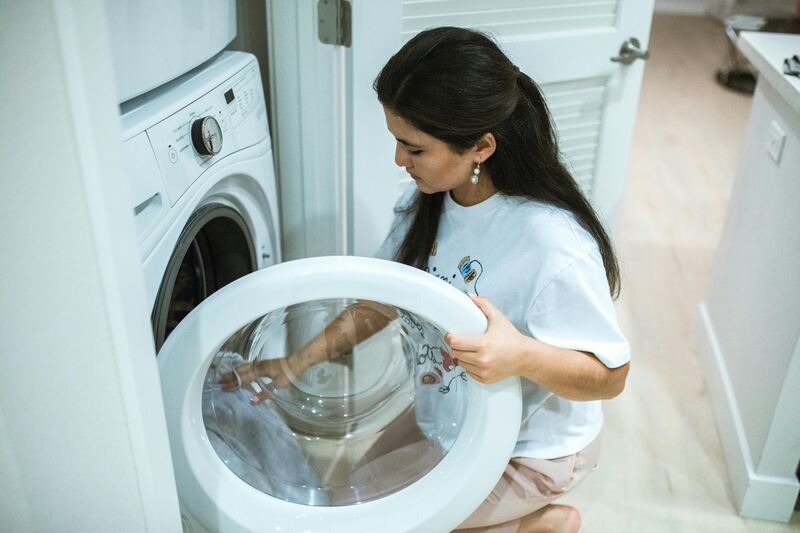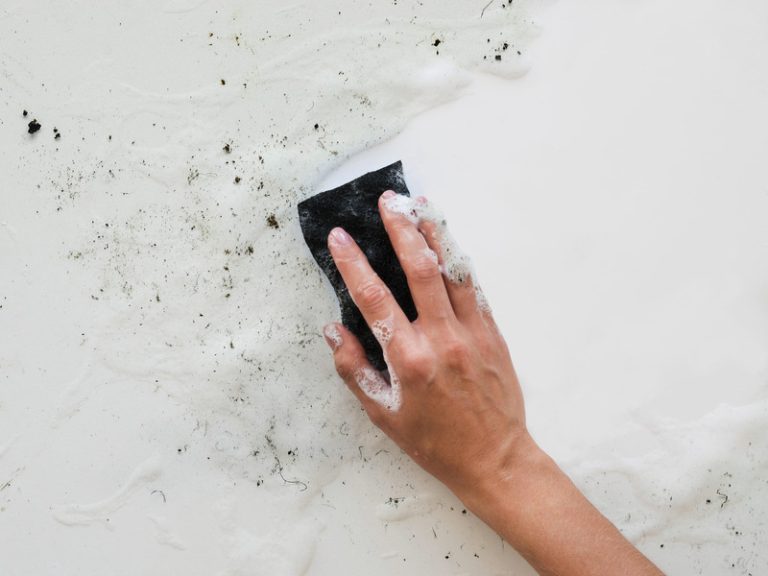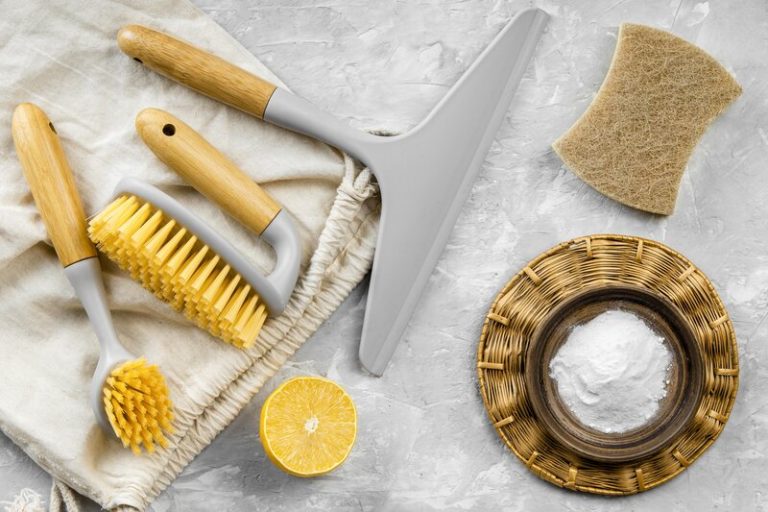Have you noticed a musty smell coming out of your washing machine? Perhaps, it is time to understand how to clean washing machine seal and apply it directly to prevent the build-up of mould and mildew.
In this article, we will give you a step-by-step guide on how to clean washing machine seal that you can easily follow.
With just a few simple ingredients like distilled white vinegar and baking soda, you can keep your washing machine seal clean and fresh.
Stay tuned for how to clean washing machine seal to its various tips and tricks to make the cleaning process even easier!
Materials Needed for Cleaning Washing Machine Seals
Before getting into the step-by-step of how to clean washing machine seal, here are some of the materials you will need for this task:
a. Distilled White Vinegar
Distilled malt vinegar is a natural cleaning agent that effectively removes mould and bacteria from washing machine seals.
Expert cleaner Joyce French recommends using vinegar for cleaning as it’s non-toxic and eco-friendly. Its antibacterial properties make it ideal for killing germs, while its acidity helps break down mould stains effectively. To use vinegar for cleaning, simply mix equal parts vinegar and water in a spray bottle. Spray the solution on affected areas, let it sit for a few minutes, then scrub gently with a sponge or brush. Rinse with water and repeat if necessary for stubborn stains. Remember to always test on a small inconspicuous area before full application to ensure compatibility with the surface.
b. Baking Soda
Bicarbonate of soda is excellent for deodorising and removing stains from washing machine seals.
When applying bicarbonate of soda to the rubber seal, ensure that it is sprinkled generously on the affected areas and left for about 15-30 minutes to work its magic. As it absorbs moisture and lifts stains, it not only cleans the seal but also helps in preventing mould and mildew growth.
Moreover, bicarbonate of soda acts as a natural deodoriser, effectively neutralising unpleasant odours such as musty smells commonly found in washing machines. For a more potent cleaning solution, you can combine bicarbonate of soda with vinegar, creating a fizzing reaction that can enhance its cleaning power and tackle tougher stains.
c. Hot Water
Hot water is used to dissolve detergents and loosen grime on washing machine seals.
When cleaning with hot water, the increased temperature plays a crucial role in enhancing the effectiveness of other cleaning agents. The heat helps in breaking down and dissolving detergent residues that can accumulate over time, especially in hard-to-reach areas like seals. By using hot water, you can ensure thorough cleaning by helping with the removal of grime that might be stubborn or require extra effort to eliminate. The combination of hot water and cleaning solutions creates a more potent solution for dealing with dirt and build-up effectively.
d. Cleaning Cloth
A cleaning cloth is essential for wiping away dirt and moisture from the washing machine seals.
When using a cleaning cloth to clean the rubber seal of your washing machine, it’s important to ensure that it is clean and dry to avoid introducing more dirt or moisture onto the seal.
Begin by gently wiping the seal with the cloth, focusing on areas where dirt and grime tend to accumulate. Use a gentle rubbing motion to effectively remove any stubborn residue.
Check the cloth regularly to see if it needs to be replaced or washed to maintain its cleaning efficacy. Taking care of the rubber seal in this manner can help prolong its lifespan and prevent any potential damage.
Step-by-Step Guide on How to Clean Washing Machine Seal
To avoid missteps, be sure to follow this step-by-step guide on how to clean washing machine seal:
a. Prepare the Cleaning Solution
To prepare the cleaning solution, mix equal parts of warm water and distilled white vinegar in a bowl, and then add a tablespoon of bicarbonate of soda.
When combining these ingredients, the warm water plays a crucial role in activating the vinegar and bicarbonate of soda, enhancing their cleaning properties. This balance ensures a powerful yet natural cleaning solution that is safe for various surfaces.
An essential tip is to mix the solution thoroughly, ensuring that the bicarbonate of soda is fully dissolved to prevent any gritty residue when cleaning. Proper mixing is key to maximising the effectiveness of the solution.
b. Soak the Seals in the Solution
Thoroughly soak the washing machine seals in the prepared cleaning solution to loosen any grime and stains.
For optimal results, it is recommended to let the seals soak for at least 30 minutes. During this time, the cleaning solution penetrates the grime buildup, softening it and making it easier to scrub away later. This process helps to break down tough stains and dirt, ensuring a thorough cleaning of the seals. It is important to avoid using strong chemicals that may damage the seals during soaking. Always read the manufacturer’s guidelines to ensure you are using safe and appropriate cleaning products for your washing machine seals.
c. Scrub the Seals with a Cleaning Cloth
Use a cleaning cloth and a toothbrush to scrub the seals, focusing on removing dirt and mould from the crevices.
When tackling stubborn grime, a toothbrush can be your secret weapon, especially for those hard-to-reach areas where dirt loves to hide. To effectively remove dirt and mould, gently scrub the seals in circular motions, ensuring you get into all the nooks and crannies. Remember, it’s crucial to be gentle during this process to avoid damaging the seal itself. By taking the time to scrub thoroughly but with care, you can restore your seals to their former glory and keep your space looking clean and fresh.
d. Rinse and Dry the Seals
Rinse the washing machine seals thoroughly with clean water, and then dry them completely to prevent any residual moisture that could lead to mould growth.
Ensuring that all cleaning agents are rinsed off properly is crucial in maintaining the cleanliness and longevity of your washing machine seals. Residue build-up can not only affect the efficiency of the seals but also create a breeding ground for mould and mildew.
After rinsing, it is equally important to dry the seals thoroughly. You can use a clean cloth to wipe them down or simply allow for natural air circulation to ensure no moisture lingers. This step is essential to prevent the growth of mould, which thrives in damp environments.
Tips and Tricks for Cleaning Washing Machine Seals
In addition to following the step-by-step guide on how to clean washing machine seal explained earlier, here are some practical tips and tricks that can help you to make this task easier:
a. Use a Toothbrush for Hard-to-Reach Areas
A toothbrush is perfect for scrubbing away dirt and grime in hard-to-reach areas of the washing machine seal.
When using a toothbrush for this purpose, it’s important to make sure that the bristles are not too firm so as not to damage the seal. Soft bristles work best for this delicate task.
Gently manoeuvre the toothbrush along the crevices where dirt tends to build up. Pay special attention to the corners and edges where grime can accumulate. Remember to rinse the toothbrush frequently while cleaning to prevent spreading dirt around. This thorough cleaning process will help maintain the seal and prevent mould and mildew growth.
b. Add Lemon Juice for Extra Cleaning Power
Adding lemon juice to your cleaning solution can provide extra cleaning power and help deodorize your washing machine seals.
One of the key benefits of using lemon juice as a natural cleaner is its acidic nature, which makes it effective in cutting through grease and grime. Not only does it leave your surfaces sparkling clean, but it also imparts a fresh citrus scent.
To incorporate it into your cleaning routine, simply mix lemon juice with water or vinegar to create a versatile cleaning solution. You can use this mixture to wipe down countertops, clean sinks, and even tackle tough stains on fabrics.
Lemon juice is known for its natural bleaching properties, making it a great choice for removing stubborn stains and brightening whites. Its antimicrobial properties also help in disinfecting surfaces, promoting a healthier living environment.
c. Regularly Clean the Seals to Prevent Build-up
Regularly cleaning your washing machine seals is crucial to prevent the build-up of mould, bacteria, and detergent residue.
By incorporating a consistent cleaning routine for your washing machine seals, you not only maintain a hygienic environment but also extend the lifespan of your appliance. Preventative maintenance is key to avoiding costly repairs and excessive wear and tear. Experts typically recommend to clean the seals once a month, use a mild detergent and warm water, and wipe down the seals thoroughly
Regular maintenance not only ensures that your laundry comes out clean and fresh but also enhances the efficiency of your washing machine by optimising its performance. Remember, a little care can go a long way in preserving the quality of your washing machine!
This is a complete explanation of the step-by-step guide on how to clean washing machine seal to various tips and tricks that can be useful for you. Cleaning the washing machine seal is crucial for maintaining hygiene and preventing mold and mildew buildup. Over time, dirt and residue can accumulate in the seal, leading to unpleasant odors and potential damage to your machine.
Professional residential cleaning services from TEKA Cleaning ensure a thorough and effective cleaning process. Our expert cleaners use specialized techniques and eco-friendly products to remove stubborn grime and maintain the longevity of your washing machine.
Ensure your washing machine seal stays clean and functional with TEKA Cleaning’s professional residential cleaning services. Contact us today at 01233 751 544 or visit our website to schedule a cleaning appointment. Let us take care of the cleaning while you enjoy a clean and well-maintained washing machine seal.
Read also:











